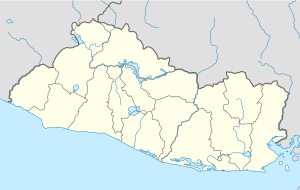Armenia (El Salvador)
| Armenia (Guaymoco) | ||
|---|---|---|
|
Coordinates: 13 ° 45 ′ N , 89 ° 30 ′ W Armenia (Guaymoco) on the map of El Salvador
|
||
| Basic data | ||
| Country | El Salvador | |
| Department | Sonata | |
| Residents | 34,912 (2007) | |
| Detailed data | ||
| surface | 65.64 | |
| height | 515 m | |
| Time zone | UTC −6 | |
| City Presidency | Carlos Alberto Molina López ( ARENA ), 2009–2012 | |
Armenia (formerly Guaymoco ) is a municipality in El Salvador in the Sonsonate department . It is in the northeast of Sonsonate on the border with the departments of La Libertad and Santa Ana .
Surname
There are two attempts to interpret the place name Guaymoco , also Guaymucuz : Pedro Geoffroy Rivas explains the Nawat name Weymuku as a “place of great stoning” from the Nahuatl roots huey (wey) “large”, motla “stony” and the locative ending -co ( -ku) . Jorge Lardé y Larín, on the other hand, traces the Nawat name Waymuku as "place of the temple of frogs" back to the roots guay (way) "frog", mumuz , short form mu "temple" and the locative ending -co (-ku) . There is no generally accepted explanation for the name Armenia, which was invented in the 19th century.
history
The old Huaymoco (or Hueymoco) was founded by the Pipil , as was Miahuatlan , which is also located in today's Municipio Armenia. Around 1200 the area came under the rule of Cuzcatlan .
The Spanish conquistador Pedro de Alvarado took Miahuatlan on June 6, 1524. After the conquest of the Pipil Empire of Cuzcatlan, Guaymoco belonged to the Alcaldía Mayor de Sonsonate . The Pipil from Miahuatlan and other places were settled in a central place which has been mentioned since 1576 under the name Guaymoco or San Silvestre Guaymoco. The main crops were cocoa , bálsamo , corn , chilli and French beans .
In 1770 there were 236 indigenous families with 790 people and 147 Ladino families with 710 people living in Guaymoco, according to the pastor José Joaquín Castaneda, so there were 383 families and 1500 inhabitants. Most of them spoke Nawat (Pipil) as their mother tongue , but also Spanish.
In 1824 Guaymoco came to the Department of Sonsonate . At that time it had 1609 inhabitants, 94 houses with roof tiles and 151 with thatched roofs.
In 1859 the community decided to get rid of the indigenous name and renamed the place San Silvestre Armenia. Nevertheless, the old name was still used for a while. In 1885 the sole name Armenia (without a saint) became valid.
Some landowners began growing coffee as early as the middle of the 19th century .
On September 9, 1919, Armenia received city rights under President Jorge Meléndez .
Attractions
In the area of the municipality , south of the place Armenia, lies the mountain Nanahuatzin . Here there are ruins from before the Spanish conquest. In the area of Azacualpa west of Armenia are the ruins of the village of Miahuatlán.
Pipil culture today
The Pipil language Nawat has practically died out as a result of the harsh repression since the genocide of the Pipil in 1932. The Santa Teresa School in the Municipio of Armenia is participating in a Nawat teaching project that has been running since 2003.
Individual evidence
- ↑ Resultados Alcaldes Electos en El Salvador para 2009-2012 ( Memento from December 28, 2010 in the Internet Archive )
- ^ Pedro Geoffroy Rivas: Toponimia náhuat de Cuscatlán. Edit. Universitaria, San Salvador, 1961, p. 101
- ↑ Jorge Larde y Larin: El Salvador, historia de sus pueblos, villas y ciudades. Biblioteca de Historia Salvadoreña, Dirección de Publicaciones e Impresos, San Salvador 2000. 2a ed., 678 p. ISBN 99923-0-054-X
literature
- Iris Estela Barrientos: Trabajo de graduación sobre los municipios de Izalco y Armenia, Departamento de Sonsonate (docente director: Luis Melgar Brizuela). Universidad de El Salvador, San Salvador 2003. 257 pp. Tesis (Licenciatura en Letras)
Web links
- HISTORIA DE ARMENIA ( Memento of March 28, 2010 in the Internet Archive ) (Spanish)
- Armenia - Tageo.com (Spanish)
- Armenia - fisdl.gob (Spanish)
- EL SALVADOR: INDICADORES DEMOGRAFICOS POR DEPARTAMENTO. 2006 ( Memento of May 5, 2010 in the Internet Archive ) (Spanish)
